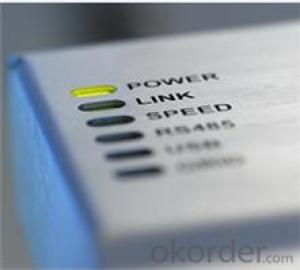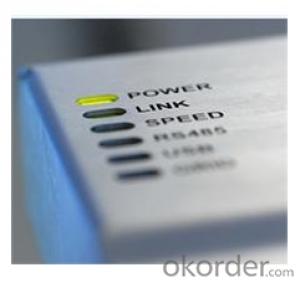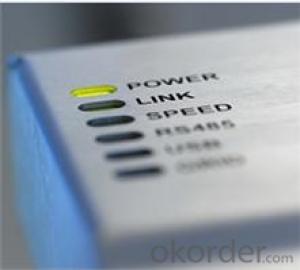On Grid Solar Inverter Monitoring Device EzLogger
- Loading Port:
- Shanghai
- Payment Terms:
- TT OR LC
- Min Order Qty:
- 10 unit
- Supply Capability:
- 100 unit/month
OKorder Service Pledge
OKorder Financial Service
You Might Also Like
Monitoring Device EzLogger
EzLogger can effectively improve the stability and reliability of commercial power station systems with its powerful monitoring, data storage and diagnostic processing. EzLogger features easy operation and powerful functions, deeply favored by our customers. Each EzLogger can support up to 20 inverters in connection while EzExplorer software can monitor 16 EzLoggers at the same time, satisfying large-scale monitoring requirements. It supports long-distance connection with inverters, which is especially convenient for commercial power station management. Its long-term data preservation is suitable for system analyzing and optimization.
| Communication | Inverter communication | RS485 |
| PC communication | 10/100 Mbit Ethernet | |
| Modem | GSM (optional) | |
| Data interface | RJ45 (RS485+Ethernet), RS232, USB2.0 | |
| Maximum Number Supported | RS485/Ethernet/Wireless(EzBee) | 20 units |
| Maximum Communication Distance | RS485[m] | 800 |
| Ethernet[m] | 100 | |
| Wireless(EzBee)[m] | 100 | |
| Power Supply | Power supply | External adapter |
| Input voltage [V] | 100V~240V AC;50/60Hz | |
| Power consumption [W] | <5< td=""> | |
| Environmental Conditions in Operation | Ambient temperature | -20~60℃ |
| Relative humidity(non-condensing) | 5%~95% | |
| Memory | Internal | 128MB in a ring buffer configuration |
| External | Mini SD card 512MB (1G /2G optional) | |
| General Data | Dimensions (WxHxD) [mm] | 150/100/43.5 |
| Weight [kg] | 0.5 | |
| Mounting location | Indoor | |
| Installation options | Wall mounting | |
| Status display | LED indicator | |
| Warranty [years] | 5 | |
| Certificates and approvals | CE |
- Q:What is the difference between a centralized and decentralized solar inverter system?
- A centralized solar inverter system has a single inverter that is responsible for converting the DC power generated by multiple solar panels into AC power for use in the building or to be fed back into the grid. In contrast, a decentralized solar inverter system has individual inverters connected to each solar panel, allowing for independent conversion of DC power into AC power. The main difference lies in the level of control and flexibility, as centralized systems typically offer more efficient power conversion but are reliant on the performance of the entire system, while decentralized systems provide greater adaptability and fault tolerance but may have slightly lower efficiency.
- Q:Can a solar inverter be used in a community solar project?
- Yes, a solar inverter can be used in a community solar project. In fact, a solar inverter is an essential component of any solar power system, including community solar projects. It converts the direct current (DC) electricity generated by the solar panels into alternating current (AC) electricity that can be used to power homes and businesses in the community. The solar inverter also helps regulate the flow of electricity and ensures the system operates efficiently.
- Q:Can a solar inverter be used with a solar-powered emergency lighting system?
- Yes, a solar inverter can be used with a solar-powered emergency lighting system. The solar inverter is responsible for converting the direct current (DC) generated by the solar panels into alternating current (AC) which is required to power the emergency lighting system. This allows the system to store and utilize the solar energy effectively, ensuring uninterrupted power supply during emergencies.
- Q:How does the quality of the AC waveform affect the performance of a solar inverter?
- The quality of the AC waveform directly impacts the performance of a solar inverter. A poor quality waveform can introduce harmonics and distortions, leading to reduced efficiency, increased heat generation, and decreased overall performance of the inverter. It can also cause issues with the functioning of other electrical equipment connected to the inverter. Therefore, ensuring a high-quality and clean AC waveform is crucial for optimal performance and longevity of a solar inverter.
- Q:What is the lifespan of the warranty on a solar inverter?
- The lifespan of a warranty on a solar inverter can vary depending on the manufacturer and model. Generally, most warranties for solar inverters range from 5 to 10 years.
- Q:Can a solar inverter be used with a solar-powered waste management system?
- Yes, a solar inverter can be used with a solar-powered waste management system. A solar inverter is used to convert the direct current (DC) electricity generated by solar panels into alternating current (AC) electricity that can be used to power various appliances and systems. In the case of a solar-powered waste management system, the solar inverter would be an essential component to convert the DC power generated by the solar panels into the AC power required to operate the waste management equipment.
- Q:Can a solar inverter be used with a backup generator?
- Yes, a solar inverter can be used with a backup generator. This allows for seamless integration of solar power and backup generator power, ensuring a continuous and reliable energy supply even during periods of low sunlight or power outages.
- Q:What is the role of a power control unit in a solar inverter?
- The role of a power control unit in a solar inverter is to regulate and control the flow of electricity from the solar panels to the electrical grid or to the connected load. It ensures efficient power conversion by managing voltage, current, and frequency, and provides protection against overvoltage, under voltage, and short circuits. Additionally, the power control unit may also include features like maximum power point tracking (MPPT) to optimize the energy output from the solar panels.
- Q:How long does a solar inverter last?
- A solar inverter typically lasts between 10 to 20 years, depending on various factors such as quality, usage, maintenance, and environmental conditions.
- Q:How does a solar inverter handle voltage regulation during high demand?
- A solar inverter handles voltage regulation during high demand by carefully monitoring the voltage levels from the solar panels and adjusting its output accordingly. When there is high demand, the inverter can increase the voltage to meet the required levels. Additionally, some advanced inverters also have features like reactive power control and voltage regulation algorithms to ensure stable voltage supply during high demand situations.
1. Manufacturer Overview |
|
|---|---|
| Location | |
| Year Established | |
| Annual Output Value | |
| Main Markets | |
| Company Certifications | |
2. Manufacturer Certificates |
|
|---|---|
| a) Certification Name | |
| Range | |
| Reference | |
| Validity Period | |
3. Manufacturer Capability |
|
|---|---|
| a)Trade Capacity | |
| Nearest Port | |
| Export Percentage | |
| No.of Employees in Trade Department | |
| Language Spoken: | |
| b)Factory Information | |
| Factory Size: | |
| No. of Production Lines | |
| Contract Manufacturing | |
| Product Price Range | |
Send your message to us
On Grid Solar Inverter Monitoring Device EzLogger
- Loading Port:
- Shanghai
- Payment Terms:
- TT OR LC
- Min Order Qty:
- 10 unit
- Supply Capability:
- 100 unit/month
OKorder Service Pledge
OKorder Financial Service
Similar products
New products
Hot products
Hot Searches
Related keywords































